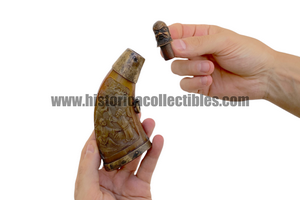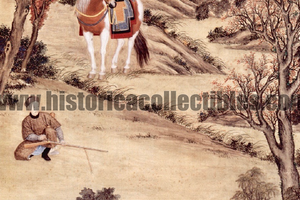Blonde Yak Horn Gunpowder Flask, 18th century China
Gunpowder flask in naturally curved and flattened blonde horn, with bronze mounts and Chinese boxwood.
The flask, made in China in the second half of the 18th century (Qinq period 1644-1912) using the final part of a Yak horn, has on both sides scenes carved and engraved in bas-relief depicting typical landscapes of the Chinese territory, with conifers and Temples with Pagodas; furthermore, in this context as a whole, there are four characters (two on each side) identified as Shaolin monks intent on facing each other by exercising the practice of Tai Chi, "fight of the extreme essence" referring to the search for harmony and balance between Yin and Yang or the two energies (feminine and masculine) which, according to Chinese thought, form the microcosm of the human being. These ritualized fights were performed by two or three dancers.
All this is understandable from the setting of the figures who are in a fighting position at close range where, in addition to the hands, the Tessen or Shàn 扇 is also used, a foldable instrument with sharp iron sticks which appeared like a common fan but in in reality it was a weapon for personal defense.
The flask is equipped with a closing terminal (cap) made of boxwood which has been meticulously carved depicting the face of Bodhidharma, 28th Patriarch of Buddhism according to the Chán/Zen tradition, a figure to whom the fighting forms of Shàolínquán (少林拳), the style of traditional Chinese martial arts. Finally, to securely secure the "cap" to the flask, it is necessary to insert the particular brass pin into the appropriate hole and rotate it half a turn.
Its state of conservation is excellent.




